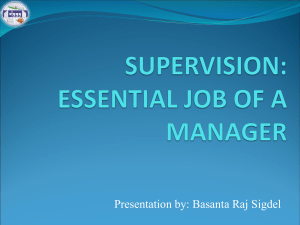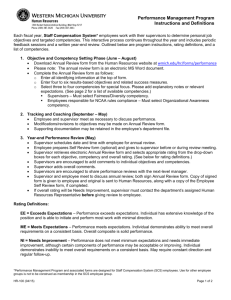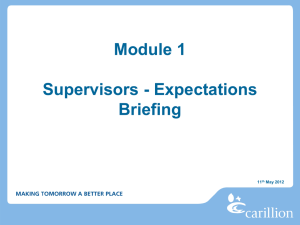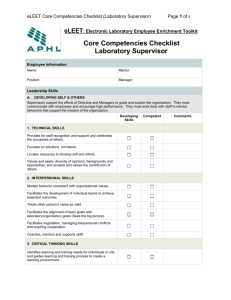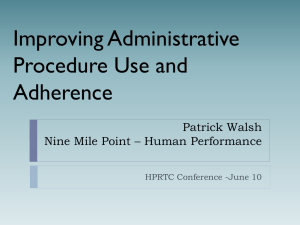Risk Assessment – An Essential Standard
advertisement
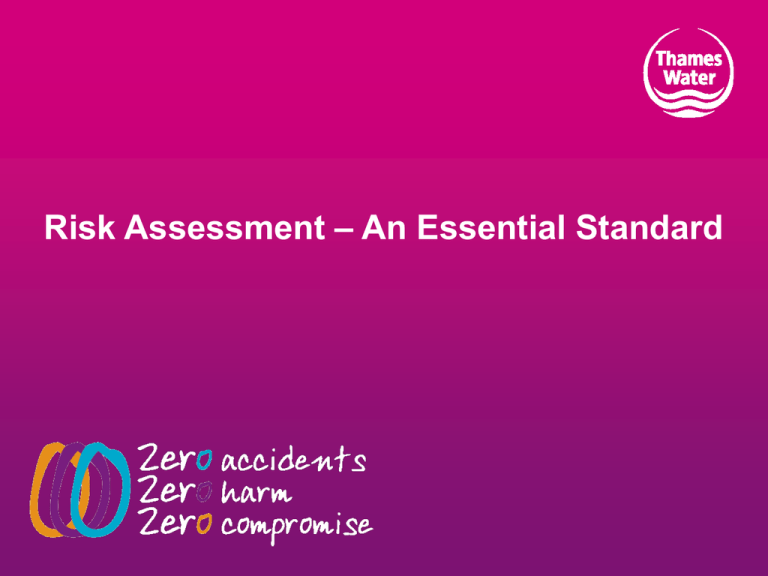
Risk Assessment – An Essential Standard Risk Assessment – An Essential Standard Agenda Introduction : • Aims and Objectives • What is a risk assessment? The importance of good risk assessment Outline of the “Essential Standard” Next stage of the initiative Risk Assessment Aims and Objectives This Best Practice initiative will be issued by Thames Water as an Essential Standard to all key suppliers and contractors working on their behalf. Aim To improve the standard of risk assessment on all Thames Water sites and eliminate / reduce risk of injury to those employed or affected by our work. Objectives • • To raise awareness of the importance of good risk assessment To give a better and more consistent approach to risk assessment on all contractors working on Thames Water sites. To identify the minimum competency for those writing and reviewing risk assessments To highlight the importance of workforce involvement in the risk assessment process • • Risk Assessment – An Essential Standard Why the initiative has been introduced? Poor risk assessment was identified as root cause in a high number of incidents including underground service strikes. A major reoccurring finding was that change control was poor i.e. the risk assessment differs from actual site practise. There was concern development of Risk Assessment was being handed to junior staff which raised concerns over the competency levels of those tasked with writing and reviewing risk assessments. Therefore This presentation and initiative have been introduced by “The Health and Safety Leadership Team” to develop a “best practise” approach Risk Assessment Introduction : What is a risk assessment? Risk assessment: A tool to help prevent accidents and ill health. It is a legal requirement. Initiative is based around the HSE guidance utilising 5-Steps to Risk assessment Step 1: What are the hazards? (anything with potential to cause harm). Step 2: Who might be harmed and to what extent? Step 3 : Asses the risk of the hazard causing harm - make staff aware of and train in the control measures. Step 4: Record the findings in a systematic manner Step 5: Periodic review - if the control measures are still appropriate. Risk Assessment The importance of good risk assessment Risk assessments are very important: • They form an integral part of health and safety management plan. • To create awareness of hazards and risks. • To identify who may be at risk • To determine if existing control measures are adequate or should be done. • To prevent injuries or illnesses (if done at the design / planning). • To prioritize hazards and control measures. Risk Assessment Legal Requirements for Risk Assessment The need for risk assessment is part of: • Health and Safety at Work, etc Act 1974 • Management of Health and Safety at Work Regulations 1999. Managers must write risk assessment to ensure that the health and safety of all employees and others who may be affected by any work activity. Other regulations also exist to cover work activities that carry specific risks, for example lifting and carrying, computer work and electricity. Essential Standard – The Roles The Information is contained with an “Essential Standard”. There are 4 role groups with responsibilities a) Managers / Supervisors b) Others with input (Engineers, H&S Professional) c) Supervisor on site d) Workforce Some company procedures also require an additional independent risk assessment review process, as part of their management systems. Essential Standard – Training and Competency Managers The Essential Standard requires Manager’s training to include: Mandatory requirements: • Company Specific Risk Assessment Process and • Core Safety training e.g. SMSTS or IOSH Optional • Communication Skills • Inspirational Leadership Essential Standard – Training and Competency Supervisors The training for the supervisors on site should be Mandatory • Company Specific Risk Assessment Process • Core safety training such as SSSTS • Inspirational Leadership Optional • Communication skills e.g. toolbox talk training • Others involved in writing and reviewing risk assessment must also be trained and competent to do so Essential Standard – Training and Competency Workforce The workforce should have the following training Mandatory • Thames Water Safety Passport Optional • Hazard recognition training • Company specific risk assessment process training • Toolbox Talk engagement Essential Standard – Procedure The procedure will require the Manager or Supervisor to: • Visit the location of work before preparing Risk Assessment • Involve the workforce and site team • Link to Method statement (if one generated) • Comply with own company procedures • Ensure change control mechanism • Review within specified period • Brief appropriate staff before work starts • Ensure this and other related documents (e.g. lift plans) are retained at the point of work • Ensure it is signed off by Manager / supervisor Risk Assessment– Input from Others There maybe other people inputting to the risk assessment process. For example: • Specialist subcontractors • Designers (e.g. temporary works) • H&S Professionals • Engineers • Management peers Their training should be the same as for Managers and supervisors and relevant to their own business procedures, specialist skills etc... Essential Standard – Communication The procedure should require supervisors on site to: • Ensure people engaged in work activities are competent • Ensure all persons involved are briefed and understand the hazards and controls to be applied • Ensure that there is a record of briefing provided and signed by those involved in the activity • Ensure a copy of the risk assessment and supporting documents are held at the place of work • Feedback proposed changes to Manager / Supervisor for approval. Essential Standard – Communication The procedure should require supervisors on site to: • Ensure people engaged in work activities are competent • Ensure all persons involved are briefed and understand the hazards and controls to be applied • Ensure that there is a record of briefing provided and signed by those involved in the activity • Ensure a copy of the risk assessment and supporting documents are held at the place of work • Feedback proposed changes to Manager / Supervisor for approval. The site supervisor should monitor the risk assessment by during regular inspections to ensure works are carried in accordance with the document. Essential Standard – Monitoring Managers and Supervisors should monitor the risk assessment by: • Ensuring it remains valid and relevant to the activity undertaken • Inspecting the site activities and conditions to ensure control measures are in place. • Recording the findings • Ensuring sub-contractors follow the essential standard. • If the risk assessment is no longer relevant, the site conditions have changed or control measures are not adequate – STOP WORK Essential Standard – Feedback and Involvement The risk assessment procedure should require the workforce to: • Actively contribute and provide feedback on risk assessment • Cooperate and play part in implementing controls and safe methods of work detailed in the risk assessment The workforce should be encouraged to report any safety concerns or changes that effect health and safety to the supervisor. Risk Assessment – An Essential Standard Summary: A legal requirement Focus on site activities as well as conditions Ensure competent people in all stages Visit site as part of the assessment process Communicate and record events Maintain vigilance We all have a part to play!!!

